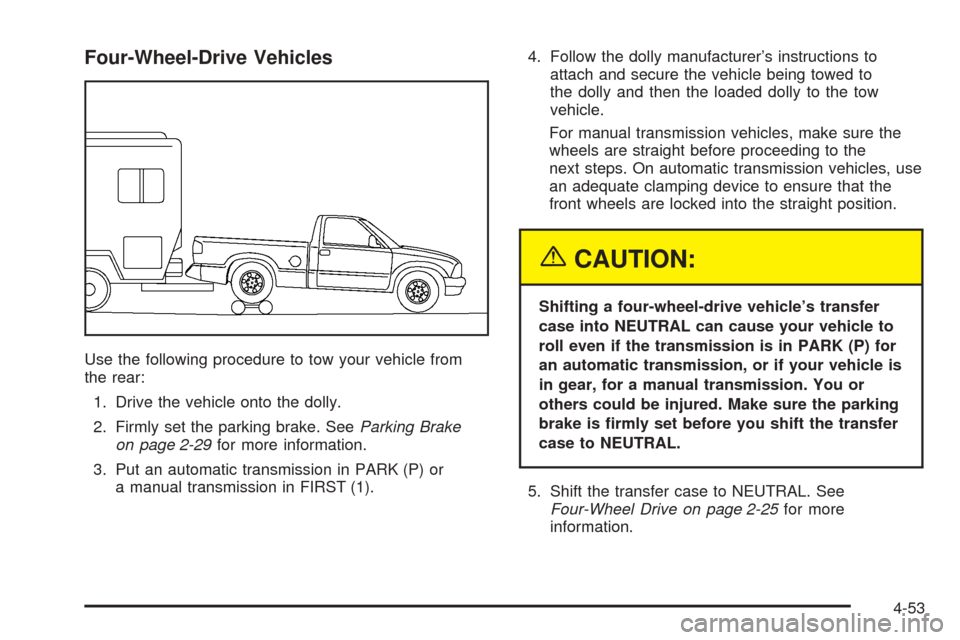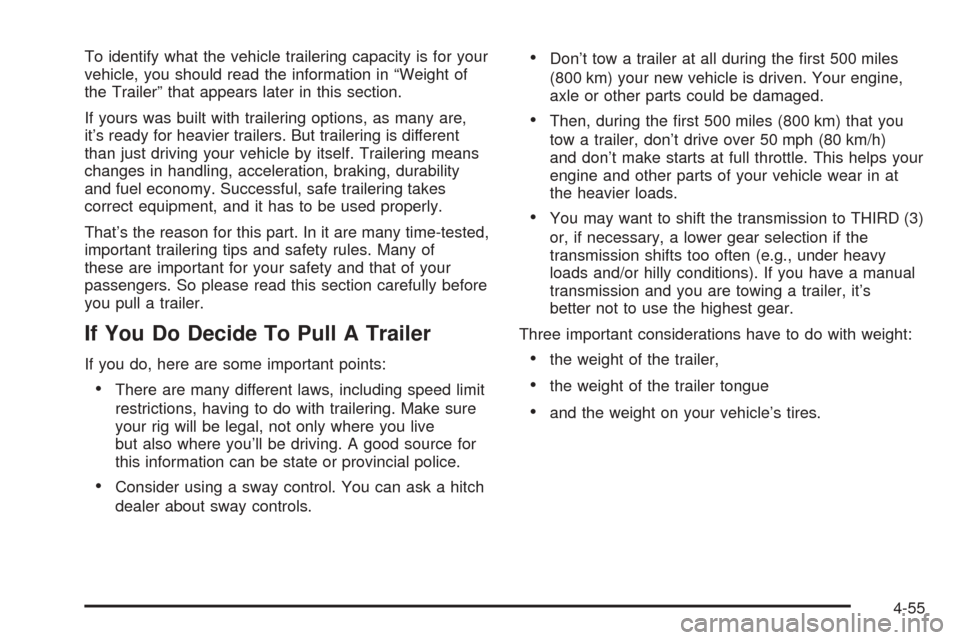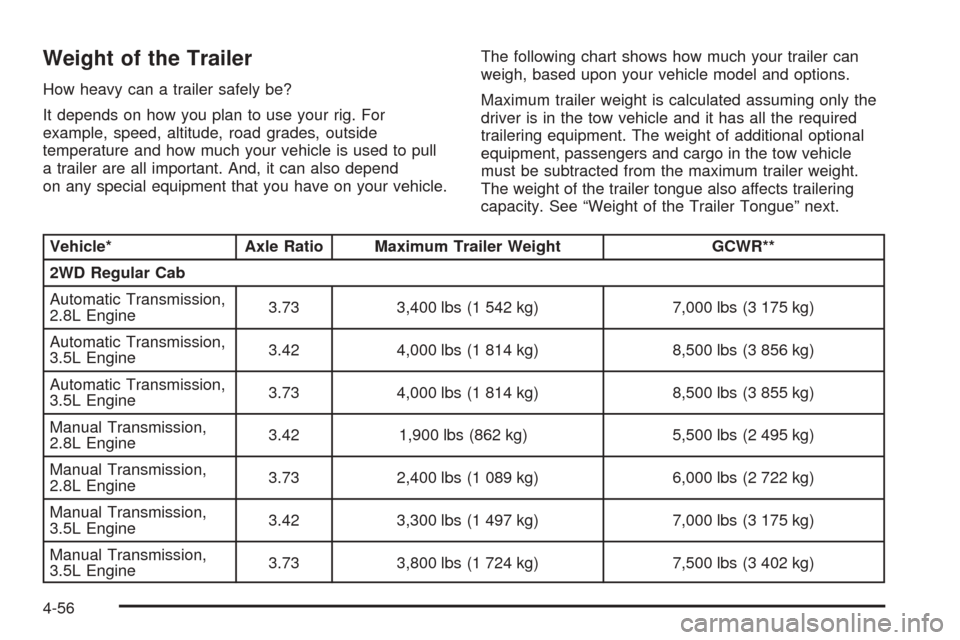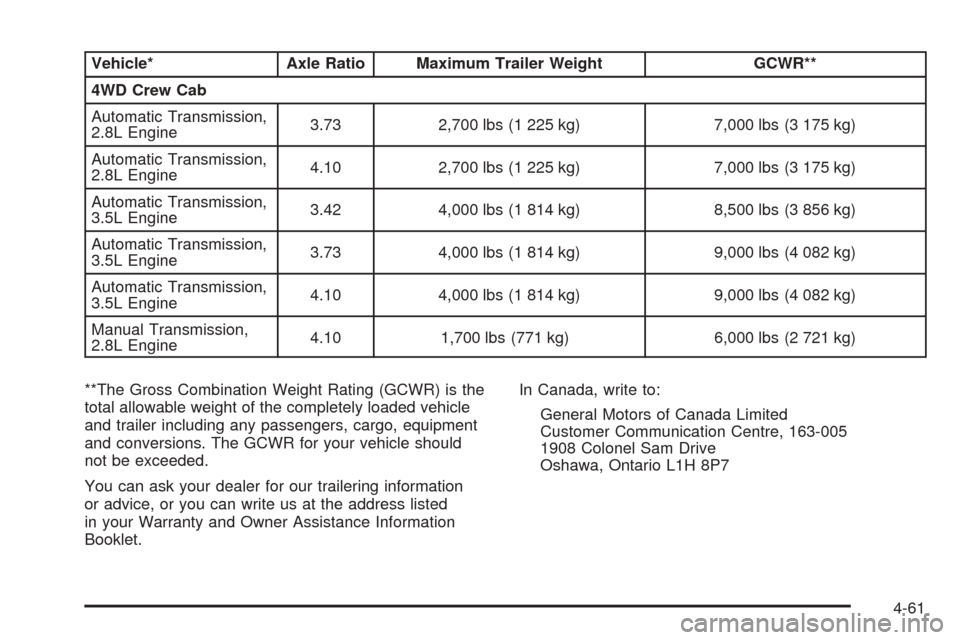Page 251 of 414

Four-Wheel-Drive Vehicles
Use the following procedure to tow your vehicle from
the rear:
1. Drive the vehicle onto the dolly.
2. Firmly set the parking brake. SeeParking Brake
on page 2-29for more information.
3. Put an automatic transmission in PARK (P) or
a manual transmission in FIRST (1).4. Follow the dolly manufacturer’s instructions to
attach and secure the vehicle being towed to
the dolly and then the loaded dolly to the tow
vehicle.
For manual transmission vehicles, make sure the
wheels are straight before proceeding to the
next steps. On automatic transmission vehicles, use
an adequate clamping device to ensure that the
front wheels are locked into the straight position.
{CAUTION:
Shifting a four-wheel-drive vehicle’s transfer
case into NEUTRAL can cause your vehicle to
roll even if the transmission is in PARK (P) for
an automatic transmission, or if your vehicle is
in gear, for a manual transmission. You or
others could be injured. Make sure the parking
brake is �rmly set before you shift the transfer
case to NEUTRAL.
5. Shift the transfer case to NEUTRAL. See
Four-Wheel Drive on page 2-25for more
information.
4-53
Page 253 of 414

To identify what the vehicle trailering capacity is for your
vehicle, you should read the information in “Weight of
the Trailer” that appears later in this section.
If yours was built with trailering options, as many are,
it’s ready for heavier trailers. But trailering is different
than just driving your vehicle by itself. Trailering means
changes in handling, acceleration, braking, durability
and fuel economy. Successful, safe trailering takes
correct equipment, and it has to be used properly.
That’s the reason for this part. In it are many time-tested,
important trailering tips and safety rules. Many of
these are important for your safety and that of your
passengers. So please read this section carefully before
you pull a trailer.
If You Do Decide To Pull A Trailer
If you do, here are some important points:
There are many different laws, including speed limit
restrictions, having to do with trailering. Make sure
your rig will be legal, not only where you live
but also where you’ll be driving. A good source for
this information can be state or provincial police.
Consider using a sway control. You can ask a hitch
dealer about sway controls.
Don’t tow a trailer at all during the �rst 500 miles
(800 km) your new vehicle is driven. Your engine,
axle or other parts could be damaged.
Then, during the �rst 500 miles (800 km) that you
tow a trailer, don’t drive over 50 mph (80 km/h)
and don’t make starts at full throttle. This helps your
engine and other parts of your vehicle wear in at
the heavier loads.
You may want to shift the transmission to THIRD (3)
or, if necessary, a lower gear selection if the
transmission shifts too often (e.g., under heavy
loads and/or hilly conditions). If you have a manual
transmission and you are towing a trailer, it’s
better not to use the highest gear.
Three important considerations have to do with weight:
the weight of the trailer,
the weight of the trailer tongue
and the weight on your vehicle’s tires.
4-55
Page 254 of 414

Weight of the Trailer
How heavy can a trailer safely be?
It depends on how you plan to use your rig. For
example, speed, altitude, road grades, outside
temperature and how much your vehicle is used to pull
a trailer are all important. And, it can also depend
on any special equipment that you have on your vehicle.The following chart shows how much your trailer can
weigh, based upon your vehicle model and options.
Maximum trailer weight is calculated assuming only the
driver is in the tow vehicle and it has all the required
trailering equipment. The weight of additional optional
equipment, passengers and cargo in the tow vehicle
must be subtracted from the maximum trailer weight.
The weight of the trailer tongue also affects trailering
capacity. See “Weight of the Trailer Tongue” next.
Vehicle* Axle Ratio Maximum Trailer Weight GCWR**
2WD Regular Cab
Automatic Transmission,
2.8L Engine3.73 3,400 lbs (1 542 kg) 7,000 lbs (3 175 kg)
Automatic Transmission,
3.5L Engine3.42 4,000 lbs (1 814 kg) 8,500 lbs (3 856 kg)
Automatic Transmission,
3.5L Engine3.73 4,000 lbs (1 814 kg) 8,500 lbs (3 855 kg)
Manual Transmission,
2.8L Engine3.42 1,900 lbs (862 kg) 5,500 lbs (2 495 kg)
Manual Transmission,
2.8L Engine3.73 2,400 lbs (1 089 kg) 6,000 lbs (2 722 kg)
Manual Transmission,
3.5L Engine3.42 3,300 lbs (1 497 kg) 7,000 lbs (3 175 kg)
Manual Transmission,
3.5L Engine3.73 3,800 lbs (1 724 kg) 7,500 lbs (3 402 kg)
4-56
Page 255 of 414
Vehicle* Axle Ratio Maximum Trailer Weight GCWR**
2WD Extended Cab
Automatic Transmission,
2.8 L Engine3.73 3,200 lbs (1 451 kg) 7,000 lbs (3 175 kg)
Automatic Transmission,
3.5L Engine3.42 4,000 lbs (1 814 kg) 8,500 lbs (3 856 kg)
Automatic Transmission,
3.5L Engine3.73 4,000 lbs (1 814 kg) 9,000 lbs (4 082 kg)
Manual Transmission,
2.8L Engine3.42 1,500 lbs (680 kg) 5,500 lbs (2 495 kg)
Manual Transmission,
2.8L Engine3.73 2,000 lbs (907 kg) 6,000 lbs (2 722 kg)
Manual Transmission,
3.5L Engine3.42 3,200 lbs (1 451 kg) 7,000 lbs (3 175 kg)
Manual Transmission,
3.5L Engine3.73 3,700 lbs (1 678 kg) 7,500 lbs (3 402 kg)
4-57
Page 256 of 414
Vehicle* Axle Ratio Maximum Trailer Weight GCWR**
2WD Crew Cab
Automatic Transmission,
2.8L Engine3.73 3,000 lbs (1 361 kg) 7,000 lbs (3 175 kg)
Automatic Transmission,
3.5L Engine3.42 4,000 lbs (1 814 kg) 8,500 lbs (3 856 kg)
Automatic Transmission,
3.5L Engine3.73 4,000 lbs (1 814 kg) 9,000 lbs (4 082 kg)
Manual Transmission,
2.8L Engine3.42 1,500 lbs (680 kg) 5,500 lbs (2 495 kg)
Manual Transmission,
2.8L Engine3.73 2,000 lbs (907 kg) 6,000 lbs (2 722 kg)
4-58
Page 257 of 414
Vehicle* Axle Ratio Maximum Trailer Weight GCWR**
4WD Regular Cab
Automatic Transmission,
2.8L Engine3.73 3,100 lbs (1 406 kg) 7,000 lbs (3 175 kg)
Automatic Transmission,
2.8L Engine4.10 3,100 lbs (1 406 kg) 7,000 lbs (3 175 kg)
Automatic Transmission,
3.5L Engine3.42 4,000 lbs (1 814 kg) 8,500 lbs (3 856 kg)
Automatic Transmission,
3.5L Engine3.73 4,000 lbs (1 814 kg) 9,000 lbs (4 082 kg)
Automatic Transmission,
3.5L Engine4.10 4,000 lbs (1 814 kg) 9,000 lbs (4 082 kg)
Manual Transmission,
2.8L Engine3.73 2,100 lbs (952 kg) 6,000 lbs (2 722 kg)
Manual Transmission,
2.8L Engine4.10 2,100 lbs (952 kg) 6,000 lbs (2 722 kg)
Manual Transmission,
3.5L Engine3.42 3,000 lbs (1 361 kg) 7,000 lbs (3 175 kg)
Manual Transmission,
3.5L Engine3.73 3,500 lbs (1 588 kg) 7,500 lbs (3 402 kg)
Manual Transmission,
3.5L Engine4.10 3,500 lbs (1 587 kg) 7,500 lbs (3 402 kg)
4-59
Page 258 of 414
Vehicle* Axle Ratio Maximum Trailer Weight GCWR**
4WD Extended Cab
Automatic Transmission,
2.8L Engine3.73 2,900 lbs (1 315 kg) 7,000 lbs (3 175 kg)
Automatic Transmission,
2.8L Engine4.10 2,900 lbs (1 315 kg) 7,000 lbs (3 175 kg)
Automatic Transmission,
3.5L Engine3.42 4,000 lbs (1 814 kg) 8,500 lbs (3 856 kg)
Automatic Transmission,
3.5L Engine3.73 4,000 lbs (1 814 kg) 9,000 lbs (4 082 kg)
Automatic Transmission,
3.5L Engine4.10 4,000 lbs (1 814 kg) 9,000 lbs (4 082 kg)
Manual Transmission,
2.8L Engine4.10 1,900 lbs (861 kg) 6,000 lbs (2 722 kg)
Manual Transmission,
3.5L Engine3.42 2,900 lbs (1 315 kg) 7,000 lbs (3 175 kg)
Manual Transmission,
3.5L Engine3.73 3,400 lbs (1 542 kg) 7,500 lbs (3 402 kg)
Manual Transmission,
3.5L Engine4.10 3,400 lbs (1 542 kg) 7,500 lbs (3 402 kg)
4-60
Page 259 of 414

Vehicle* Axle Ratio Maximum Trailer Weight GCWR**
4WD Crew Cab
Automatic Transmission,
2.8L Engine3.73 2,700 lbs (1 225 kg) 7,000 lbs (3 175 kg)
Automatic Transmission,
2.8L Engine4.10 2,700 lbs (1 225 kg) 7,000 lbs (3 175 kg)
Automatic Transmission,
3.5L Engine3.42 4,000 lbs (1 814 kg) 8,500 lbs (3 856 kg)
Automatic Transmission,
3.5L Engine3.73 4,000 lbs (1 814 kg) 9,000 lbs (4 082 kg)
Automatic Transmission,
3.5L Engine4.10 4,000 lbs (1 814 kg) 9,000 lbs (4 082 kg)
Manual Transmission,
2.8L Engine4.10 1,700 lbs (771 kg) 6,000 lbs (2 721 kg)
**The Gross Combination Weight Rating (GCWR) is the
total allowable weight of the completely loaded vehicle
and trailer including any passengers, cargo, equipment
and conversions. The GCWR for your vehicle should
not be exceeded.
You can ask your dealer for our trailering information
or advice, or you can write us at the address listed
in your Warranty and Owner Assistance Information
Booklet.In Canada, write to:
General Motors of Canada Limited
Customer Communication Centre, 163-005
1908 Colonel Sam Drive
Oshawa, Ontario L1H 8P7
4-61